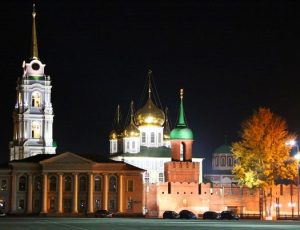The main historic site in Tula is the Tula Kremlin.

Location of Tula made the city an important place at the approaches to Moscow, thus the city has long been the southern fortress of the Moscovy state. The glorious Tula Kremlin has never been conquered by the invaders and repelled the enemy attacks all the times. Its construction started at the beginning of 16th century when Tula was again and again ruined by nomads. High battlements crowned with 9 watch towers were constructed around the rectangular perimeter. Barely the construction of the first Kremlin fortifications had been completed, the troops of Khan Davlet I Gyrei came. The bloody and desperate battle began. Whistling arrows of the enemy decimated the ranks of the defending natives, the city was almost ruined but the repulse was done. Boiling resin was pouring down on the heads of assaulting enemy and Tataro-Mongol hordes had to retreat. Those were the last years of Horde rule, soon Kazan was captured, but Tula natives had to repulse romads for several times – the special fortification line near Tula still existed for one and a half century.
At that time all the city inhabitants lived within the Kremlin fortress walls.
The first city street, Kremlyovskaya, had 107 courts, Orthodox churches towered in the city. It was the time when the history of famous Tula gun smiths began – the blacksmiths of Tula were exempted from duties and taxes by the Tzar decree to make weapons for the state. They also made various items of household.
Tula Kremlin is the remarkable monument of old Russian fortification. Last years it was greatly restored to demonstrate not only the fortification architecture of that time but even the nature of defensive battle. Construction of Tula Kremlin began in 1507 by the decree of Vasily III, the Grand Duke of Moscow. Strategically it was erected on the left less floodable bank of Upa river that was not inhabited by that time, as archeological excavation proves. The construction was completed in 1520.
There are nine towers in Tula Kremlin – round and blind Spasskaya, Naugolnaya, Ivanovskaya and Nikitskaya towers. There are rectangular travel towers along the western, southern and eastern walls. There were two towers on the northern bank wall – travel Bashnya Vodyanykh vorot and blind Bashnya na pogrebu. Those towers significantly protrude in front of city walls, that provided possibility of frontal and flank combat. Each tower had 3-4 floors. Apart from regular firing ports there were ports for hinge and oblique fire. The travel towers had thick oak gates and portcullis. There were special ports to fire at the enemy that intruded inside.

